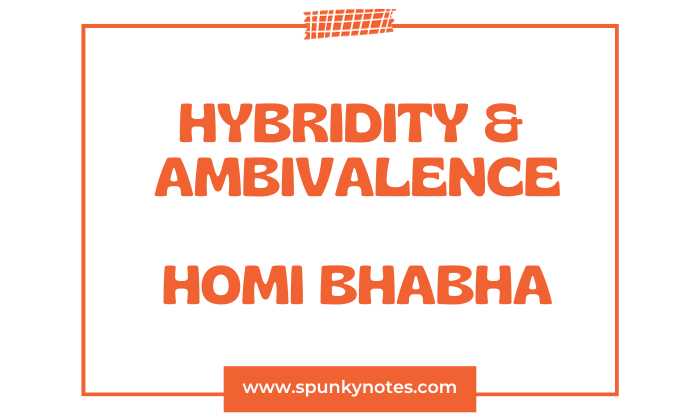

Estimated Reading Time: 7 min
Q. Discuss the concepts of hybridity and ambivalence by Homi Bhabha.
Homi K. Bhabha first extensively articulated his concept of hybridity in his work “The Location of Culture,” published in 1994. This book is a cornerstone in postcolonial studies and has significantly influenced how we understand cultural interaction, especially in the context of colonialism and its aftermath.
Hybridity
Mixing of Cultures: Imagine two different paint colors. When they are mixed, they transform into a new color. Hybridity is like this, but with cultures. When people from different cultures meet, their traditions, languages, and ideas mix to create something new and unique.
New Identity Creation: This mixing leads to new kinds of identities. For example, someone might have parents from two different cultures. They grow up with both influences, so they do not belong to just one culture but a mix of both. This new identity is a result of hybridity.
Breaking Stereotypes: Hybridity shows us that cultures are not fixed or pure. They are constantly changing and influenced by other cultures. It breaks down stereotypes, which are often based on the idea that cultures are static and separate.
Bhabha argues that hybridity is a crucial concept to understand the complexity of our modern, globalized world. It challenges the idea that cultures are fixed and separate from each other.
Instead of viewing cultures as static, it acknowledges their constant evolution and mutual influence. It is similar to how people from different backgrounds create a unique mix of customs, languages, and traditions in a multicultural city.
Example
One example of hybridity is “Spanglish,” a blend of Spanish and English spoken by many Hispanic communities in the United States. It is not pure Spanish or English but a mixture of both, shaped by the unique experiences and interactions of those who speak it.
Hybridity also challenges the notion of a single, fixed identity. Bhabha suggests that individuals can have multiple identities that are not confined to one specific culture.
For instance, someone might identify as both Asian and American, embracing elements of both cultures in their daily lives.
However, Bhabha does not see hybridity as a simple celebration of diversity. He acknowledges that hybridity can also be a site of tension and conflict.
When different cultures come into contact, power dynamics can play a significant role, leading to issues of dominance and subordination.
Ambivalence
Eugen Bleuler, a Swiss psychiatrist, first introduced the term “ambivalence” in his 1910 article Vortrag über Ambivalenz. He used it in the context of psychiatric studies, particularly to describe a symptom of schizophrenia.
Bleuler’s concept of ambivalence was later adopted and adapted in different fields. In postcolonial studies, for instance, Homi K. Bhabha used the term to describe the complex and contradictory relationships between colonizers and colonized peoples.
Bhabha’s exploration of ambivalence is notably found in his influential work “The Location of Culture,” published in 1994, where he applied the concept to cultural and postcolonial discourse.
Ambivalence by Homi Bhabha
It refers to the mixed feelings and attitudes that arise after colonialism. Colonized societies embrace aspects of the colonizer’s culture while resenting the oppressive history of colonization.
Ambivalence in this context represents the multifaceted response to the collision of different cultures, power dynamics, and identities. It shows the ongoing struggle to reconcile the past with the present in postcolonial societies.
Bhabha argues that ambivalence is fundamental to our human experience, especially in a multicultural and globalized world. Individuals and groups may experience ambivalence about their cultural identity when different cultures come into contact.
They might feel torn between embracing their cultural roots and adopting elements of the dominant culture. Ambivalence can also be seen in power dynamics.
There can be ambivalent feelings in situations where one group has more power than another. The subordinate group may admire and desire the dominant group’s power yet also resent it.
Furthermore, Bhabha suggests that ambivalence can generate creativity and resistance. It is not always a negative feeling. Amid ambivalence, new ideas, identities, and forms of expression can emerge.
For example, in literature and art, ambivalence can lead to creating works that challenge established norms and provoke critical thinking.
Ambivalence in Postcolonial Studies
Ambivalence, as used by Homi K. Bhabha in postcolonial studies, is about the complicated feelings between colonizers and the people they colonized.
Mimicry leads to ambivalence because it creates a complicated relationship between the colonizer and the colonized.
On the one hand, the colonized are imitating the colonizer, which might seem like admiration or aspiration. On the other hand, this imitation is never perfect and can be seen as a form of resistance or mockery.
Not Just Opposition: In a colonial situation, the colonized people do not just dislike the colonizers. Their feelings are mixed. They might see some things in the colonizers’ culture that they find appealing or superior, even while they resent their control and dominance.
How They See Each Other: For the colonized, the colonizer can seem powerful and something to aspire to, but also corrupt and oppressive. For the colonizer, the colonized are not only seen as lesser but also as interesting or foreign. This duality reflects the complex nature of their relationship.
The colonized may admire certain aspects of the colonizer’s culture, technology, or way of life. However, they simultaneously resent the colonizer’s authority and the impact of colonization on their own culture and identity.
Bhabha’s concept of ambivalence also highlights that this complexity is reciprocal. The colonizer often views the colonized as both inferior and fascinatingly different.
This fascination can manifest as a romanticized view of the colonized as noble savages or as bearers of a purer, more primal culture. This perspective, however, coexists with attitudes of superiority and a desire to dominate or change the colonized.
Difference Between Hybridity and Ambivalence by Homi Bhabha
Hybridity
Mixing of Cultures
-
- Hybridity happens when different cultures come together and blend. This mix creates new cultural forms, like new ways of living, thinking, or expressing art and language.
- It is like when two different colors blend to make a new color.
Changing Identities
-
- This blending changes how people see themselves and their culture. It shows that no culture is pure or unchanged; others always influence them.
- It is like how your personality might change when you make new friends from different backgrounds.
Breaking Old Views
-
- Hybridity challenges the old ideas that cultures are fixed and separate. It shows that cultures are constantly interacting with and influencing each other.
- It is similar to realizing that learning from others can change your old beliefs.
New Creations
-
- It is not just about mixing; it is about creating new things. It can be new types of music, fashion, or even new ways of thinking.
- Think of it like cooking a new dish by combining ingredients from different cuisines.
Ambivalence
Mixed Feelings
-
- Ambivalence in postcolonial settings is about having conflicting feelings. For example, colonized people might admire the colonizer’s culture but also resent their power and control.
- It is like having a boss you respect but also dislike because they have authority over you.
Emotional Complexity
-
- This concept focuses on the complex emotions in colonial relationships. These emotions are not straightforward; they are complicated and often contradictory.
- Imagine liking someone’s style but disliking their attitude. That is ambivalence.
Understanding Power Dynamics
-
- Ambivalence helps us understand the tricky power play between the colonizer and the colonized. It is about seeing how these roles affect feelings and attitudes.
- It is like understanding that power can make relationships complicated.
Contradictions in Views
-
- It shows the contradictions in how colonized people view their colonizers. These views are not black and white but have many shades of grey.
- Think of it as liking certain aspects of a culture while disagreeing with others.
Hybridity is simply about how cultures mix and create new, blended identities. It is a positive, creative process. Conversely, ambivalence is about the complex and conflicting feelings that people in colonial relationships experience. It is more about the emotional tug-of-war in these situations.


